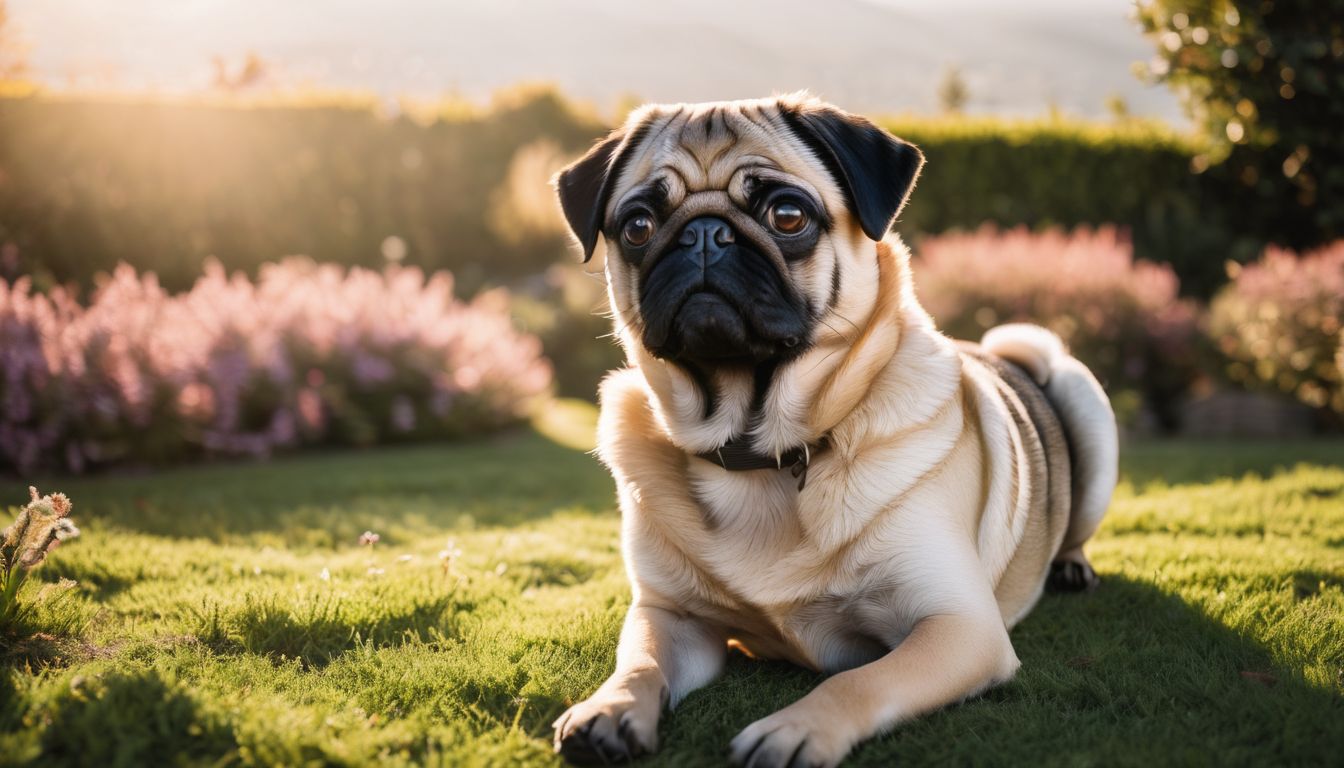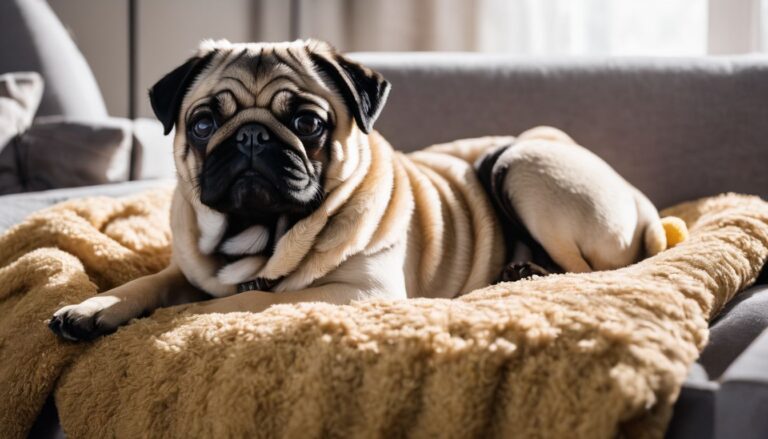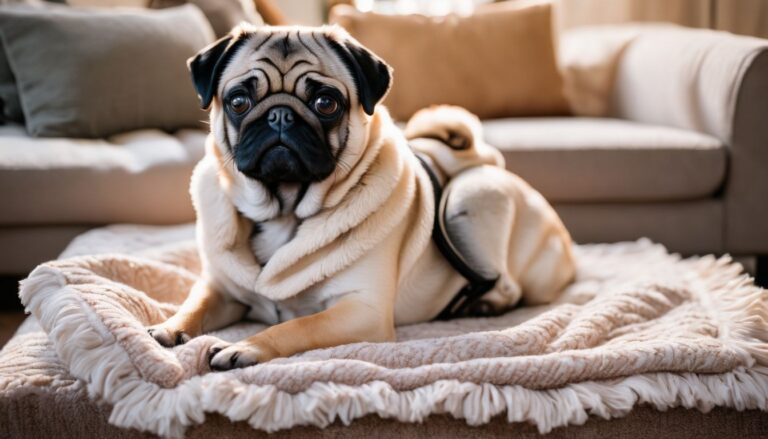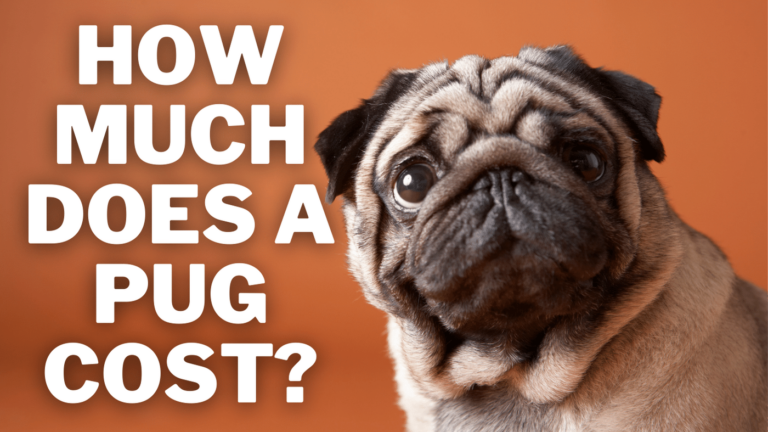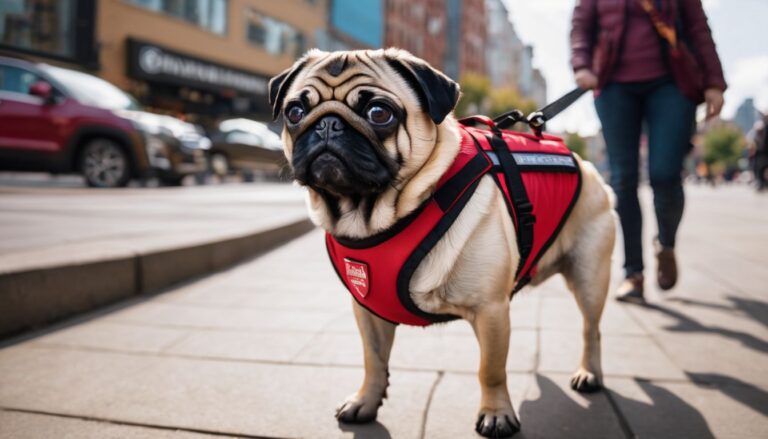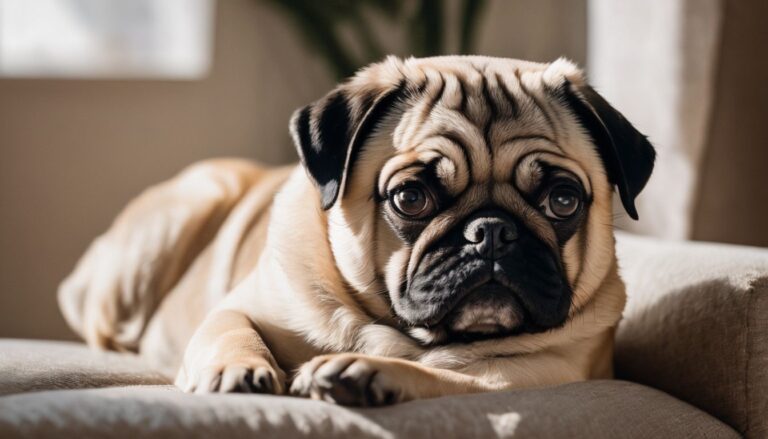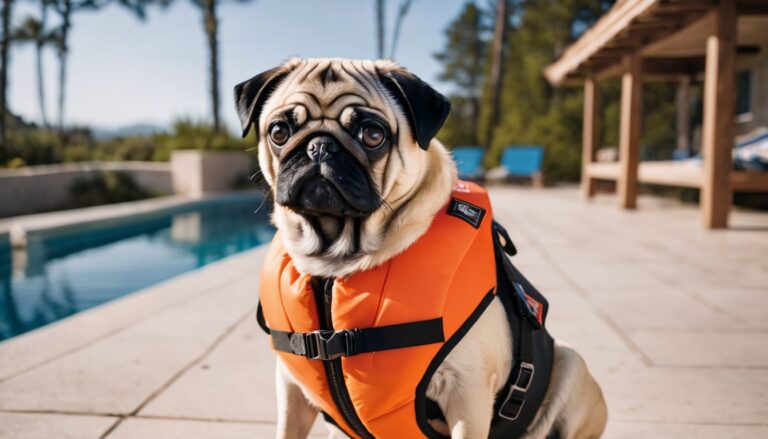Are Pug Dogs Hypoallergenic? Debunking Allergy Myths And Facts
Are pug dogs hypoallergenic?
Cuddling up with your endearing pug is one of life’s simple joys, isn’t it? But for some of us, that joy is accompanied by a symphony of sneezes and the all-too-familiar dance of watery eyes—pet allergies don’t discriminate.
That’s why our team has rolled up their sleeves to get to the heart of a common question: Are pugs kind to those with allergies? Let’s face it, turning down snuggle time with those squishy-faced cuties just doesn’t seem fair.
In this enlightening article, we’re busting myths left and right about pugs and their hypoallergenic status. Heck, you may be surprised to learn that Labs—those beloved fetch champions—are often mislabeled as allergy triggers when they might be easier on your sinuses than you think! Stick around as we guide you through the ins and outs of navigating dog-loving life when allergies are part of your reality.
We’re here to arm you with facts (and maybe a few tissues) so living harmoniously with your four-legged friend is nothing to sneeze at!
Key Takeaways
- Pugs are not hypoallergenic. They shed year-round and produce dander, a common allergen.
- No dog is completely hypoallergenic, but there are breeds with lower tendencies to cause allergies due to less shedding or different types of fur.
- Regular grooming and cleaning can help minimize the allergens from pugs, including frequent brushing and bathing.
- Allergy sufferers should consider other hypoallergenic breeds like Bichon Frises, Poodles, or Schnauzers if they want a pet that might be easier on their allergies.
- Medications and air purifiers can also assist people with pet allergies in managing symptoms while living with dogs.
Understanding Pet Allergies

Understanding Pet Allergies: When our immune systems overreact to the tiny flakes of skin, or dander, from our furry friends, we experience pet allergies. Let’s explore what triggers these responses and how we can identify and manage the symptoms that come with loving a pet a little too much for our bodies to handle.
What Causes Pet Allergies in Humans?
Pet allergies in humans are often triggered by proteins found in an animal’s dander, which is tiny flakes of skin. Even our beloved pugs, with their short coats, can cause these allergic reactions because all dogs produce some amount of dander.
Alongside the skin flakes, pet saliva and urine also contain allergenic proteins that become airborne as they dry out or get stuck on their fur. When we pet or cuddle them, or even just share space with our furry friends at home, these particles can hitch a ride on dust and spread throughout the environment.
Many of us notice allergy symptoms flare up when we’re around dogs; it’s not actually dog hair that’s to blame but rather what’s attached to it – mainly the dander and dried saliva.
While our pugs shed less compared to some other breeds due to their shorter coat length, they still release enough allergens into the air to potentially affect sensitive individuals.
Regular grooming can help reduce this shedding and may lower the amount of allergens present in your living spaces but won’t eliminate them completely since no breed is 100% hypoallergenic.
Common Allergens Found in Pet Dander
Moving from the causes of pet allergies, let’s focus on the specific allergens lurking in pet dander. These tiny particles are not just from fur, but include proteins found in a dog’s saliva, urine, and dead skin cells.
Pugs may have short hair that doesn’t seem to shed much, yet their dander can still pack a punch for allergy sufferers. They carry allergenic proteins which can stick to their coat and become airborne as they move around the house.
Most notably, a protein named Can f 1 is commonly present in dog dander and is one of the main culprits behind allergic reactions. While pugs produce less dander than some breeds with double coats or longer hair, these proteins can still cause sneezing fits and itchy eyes for sensitive people.
Frequent grooming helps manage this issue by removing loose hairs before they spread allergens throughout your living space. Regular cleaning and using air purifiers can also reduce allergic reactions by minimizing exposure to these irritant particles at home.
Allergy Symptoms
Understanding common allergens in pet dander sets the stage for recognizing how they affect us. Allergies can reveal themselves through various symptoms that disrupt our daily lives. Here’s a rundown of the allergy symptoms that might hit pug lovers and dog enthusiasts alike:
- Sneezing fits often strike out of nowhere, especially when you’re around pet hair or dander.
- Itchy, watery eyes make it seem like you are constantly fighting back tears, and they’re not from watching a sad movie.
- You may experience a runny or stuffy nose, making it hard to breathe clearly.
- Some people notice their skin developing red patches or hives after close contact with dogs.
- Dog allergies can cause an itchy throat or coughing, disrupting conversations and your sleep.
- In severe cases, individuals could experience asthma attacks triggering shortness of breath and chest tightness.
- Regular headaches can be a telling sign of an ongoing allergic reaction to pets.
Hypoallergenic Dog Breeds
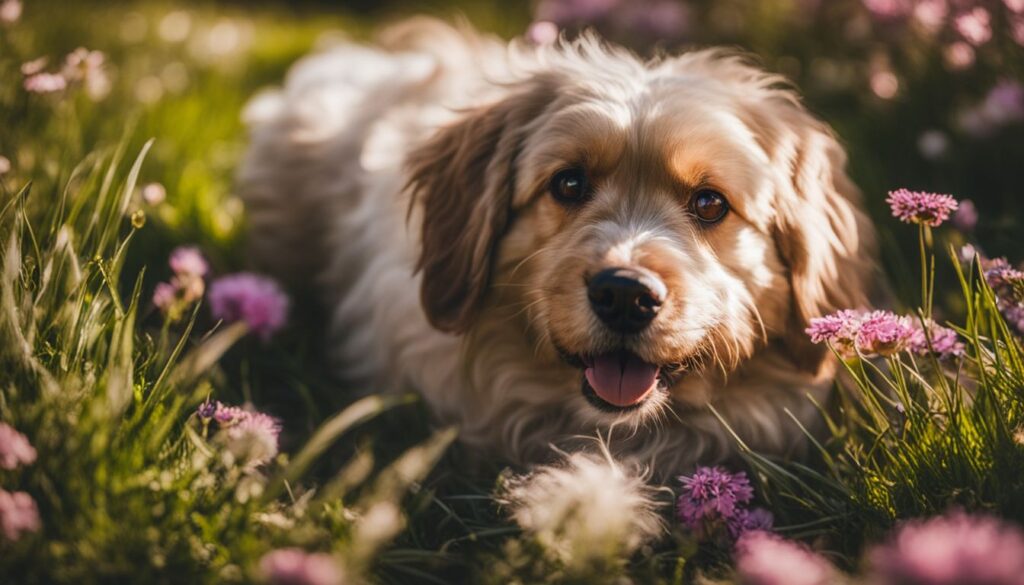
As we delve into the world of hypoallergenic dog breeds, it’s essential to understand which furry friends have less impact on allergy sufferers. The American Kennel Club identifies certain breeds as more suitable for those with sensitivities, so let’s explore what makes a dog hypoallergenic and discover some top contenders in this category that might be a better fit for you than our beloved pugs.
Criteria for Hypoallergenic Breeds
When we look for a hypoallergenic breed, we’re really searching for dogs that have a lower tendency to cause allergies. These breeds often shed less fur and produce fewer allergens in their dander and saliva.
It’s not just about how much they shed, though; it’s also the kind of fur. Breeds with hair that grows continuously, like Poodles or Bichon Frises, often get tagged as hypoallergenic because they don’t release as much hair into the environment.
We must understand that no dog is completely allergy-proof, but some are better suited for allergy sufferers than others. The American Kennel Club provides lists of potential hypoallergenic dog breeds that might fit well into homes with sensitive individuals.
Regular grooming and cleaning become essential parts of pet care to minimize exposure to allergens. Next up, let’s dive deeper into which breeds make the list as most hypoallergenic and why pugs might not be ideal if your nose runs at the sight of fur.
Most Hypoallergenic Breeds
As pug lovers, we cherish the friendly and affectionate nature of these small dogs. However, when it comes to allergies, it’s important to be aware that there are indeed breeds which are better suited for allergy sufferers.
- The American Hairless Terrier is a remarkable option for those concerned about pet allergies. This breed lacks hair, which dramatically reduces the presence of dander, often the main culprit behind allergic reactions.
- Poodles of all sizes, whether standard, miniature, or toy, boast a curly coat that traps dander and requires regular grooming. Their low-shedding fur makes them a popular choice among hypoallergenic dog seekers.
- Siberian Huskies might surprise you; despite their thick double-coat, they produce lower levels of dander. Still, they do require consistent grooming to minimize allergen spread in the home.
- Bichon Frise dogs possess a soft and curly coat similar to poodles that doesn’t shed much. These cheerful pups need frequent grooming but their maintenance can greatly reduce allergic symptoms.
- Maltese are beloved for their silky white hair and charming personalities. They shed very little and with regular brushing, keep dander at bay making them great companions for sensitive noses.
- The Affenpinscher comes with a wiry coat that sheds less frequently than many other breeds. Routine grooming keeps their shedding under control and allergens in check.
- Schnauzers of any size have distinctive coats that don’t shed excessively. Regular grooming sessions help maintain this advantage.
- Labradoodles – a mix between Labrador Retrievers and Poodles – were initially bred as hypoallergenic guide dogs. Their popularity has soared due to their generally lower levels of shedding and dander production.
- Portuguese Water Dogs have tight curls that do well in keeping dead hair from falling out freely. They’ve gained fame in the hypoallergenic dog world since one famously lived in the White House without causing allergy flare-ups.
Least Hypoallergenic Breeds
We love our pugs, but we need to face the truth about their allergenic potential. Despite their charming wrinkles and affectionate nature, they are one of the least hypoallergenic dog breeds.
- Pugs rank high on shedding despite their short coats because they shed all year round.
- These dogs produce a fair amount of dander; it’s less than some breeds but still significant for those with allergies.
- Pet lovers should know that Pugs can also carry other allergens in their fur, such as pollen or mold from outdoors.
- Surprisingly, large breeds like Golden Retrievers and Siberian Huskies also made the list of less hypoallergenic dogs due to their heavy shedding and dander production.
- Labrador Retrievers, often thought to be non – hypoallergenic, actually have lower levels of allergens compared to many other breeds.
- A Teacup Pug might seem like a lesser threat due to its size, yet its genetic makeup remains unchanged — it is not more hypoallergenic than standard-sized Pugs.
- Regular grooming can help manage the amount of hair and dander these dogs produce; however, it does not change their fundamental nature as allergy triggers.
- While Puggles—a mix between a Pug and a Beagle—are adorable, they inherit qualities from both sides making them unsuitable for people with severe dog allergies.
Debunking the Myth: Are Pugs Hypoallergenic?
Shedding and Dander Production
Pugs may be small and adorable, but their shedding can pack a punch. These little dogs shed throughout the entire year, making it tough for allergy sufferers to keep symptoms at bay.
Unlike some larger dog breeds that go through seasonal shedding frenzies, pugs drop their short hairs consistently. This means you’ll often find fine pug hair on your furniture, clothes, and floating in the air.
The trouble doesn’t stop with just hair; pugs also produce dander—the flakes of skin that accompany the fur they shed. While they might not generate as much dander as their long-haired cousins do, this does not mean they are safe for people with pet allergies.
Tiny particles of dander can trigger sneezes, runny noses, and itchy eyes even in those mildly sensitive to allergens. Regular grooming can help manage dander levels but won’t eliminate the problem altogether since no dog is truly hypoallergenic.
Allergens in Pugs
Pugs charm us with their wrinkled brows and expressive eyes, but they also bring along a less endearing trait – allergens. These cuddly canines are not the best match for allergy sufferers as they shed throughout the year.
While pugs do have short coats, this does not mean they are low on allergens; in fact, their dander can easily trigger allergic reactions. They may have less fur to leave around the house compared to fluffier breeds, yet this doesn’t make them hypoallergenic.
If you love these furry friends but struggle with pet allergies, be cautious. Despite being smaller in size and having shorter hair than many other dogs, pugs still produce enough dander to cause discomfort for individuals sensitive to allergens.
It’s important to note that while some dog breeds might be promoted as ‘hypoallergenic’, no breed is truly free of potential allergens. That includes our beloved pugs who unfortunately rank high on the list of pets that could stir up those pesky symptoms like sneezing or itchy eyes.
Tips for Dog Owners with Allergies
Even if you’re smitten with pugs but struggle with allergies, there are proactive steps you can take to coexist comfortably with your furry friend—stay tuned for effective strategies that can help.
Preparation for Bringing Home a Pug
As Pug Lovers of the World, we cherish the joy these little dogs bring into our lives. Before you welcome a pug into your home, it’s crucial to prepare for their arrival, especially if you have allergies.
- Choose the right supplies. Your pug will need a comfortable bed, bowls for food and water, toys to play with, and a good-quality leash for walks.
- Invest in quality grooming tools. Regular brushing helps minimize shedding. Look for brushes specifically designed for short-haired breeds.
- Opt for hypoallergenic bedding. To reduce allergens, select bedding that’s easily washable and made from materials that don’t hold onto dander.
- Stock up on allergy-fighting products. Allerpet solutions can be gently applied to your pug to reduce dander levels before they spread around your house.
- Develop a cleaning routine. Frequent vacuuming with HEPA filters and mopping can keep allergen levels low in areas where your pug spends time.
- Learn about dog grooming. Find reputable groomers or learn techniques yourself to keep your pug clean and reduce potential allergens.
- Seek advice from an allergist. It might be worthwhile discussing how owning a pug could impact your allergies and exploring treatment options like allergy shots or antihistamines.
- Set aside an allergy-free zone. Create an area in your home where your pug is not allowed, so you have a space with less exposure to allergens when needed.
- Consider air purifiers. These devices can help remove pet dander from the air in your home, making it easier for those with allergies to breathe.
Grooming and Cleaning Tips
Grooming and cleaning are crucial for keeping your pug healthy and reducing allergens in your home. Our furry friends might not be hypoallergenic, but with the right care routine, we can enjoy our time together with fewer sniffles.
- Invest in a high-quality brush specifically designed for short-haired breeds like pugs; it will help capture loose fur and mitigate shedding.
- Establish a regular brushing schedule, aiming to groom your pug at least twice a week to minimize dander spread.
- Bathe your pug monthly using a gentle shampoo recommended by veterinarians to keep their skin healthy and reduce potential allergens.
- Clean your pug’s wrinkles daily with a damp cloth to prevent buildup of dirt and bacteria, which can exacerbate allergy symptoms.
- Use hypoallergenic wipes on your pug after walks to remove pollen or dust that may cling to their coat during seasonal allergies peak times.
- Wash pet bedding, blankets, and any soft items they use regularly in hot water to kill dust mites and remove accumulated dander.
- Vacuum frequently with a cleaner featuring a HEPA filter to effectively trap pet hair and finer particles associated with pet allergies.
- Opt for air purifiers in areas where your pug spends most of their time to capture airborne allergens and improve indoor air quality.
- Consult your veterinarian about special diets or supplements that can support skin health and potentially lead to reduced shedding.
Non-Allergenic Pet Options
For those who love pets but struggle with allergies, we’ve uncovered some fantastic non-allergenic companions that might surprise you – read on to discover how these alternatives could be the perfect fit for your home and lifestyle.
Alternatives to Pugs for Allergy Sufferers
As dog lovers, we understand the struggle of pet allergies. Despite our love for pugs, we acknowledge that they might not be suitable for everyone due to allergens.
- Consider the Bichon Frise, praised for its low shedding, which makes it a favorite among allergy sufferers.
- Look into breeds like the Schnauzer; their distinctive fur traps dander and requires regular grooming to keep allergens at bay.
- The Maltese is another excellent option, with silky hair that grows long and sheds very little.
- You might also find friendship with a Shih Tzu whose hair grows like a human’s and can be kept long or trimmed short.
- The Portuguese Water Dog boasts a hypoallergenic coat that has gained popularity after President Obama chose one for its allergy-friendly qualities.
- Research the Soft Coated Wheaten Terrier as it also ranks high in compatibility for those with allergies due to its single-layered coat.
- Don’t overlook smaller breeds like the Bolonka; they are known for minimal shedding and could be ideal companions.
Managing Pet Allergies
Discovering the right balance between your love for dogs and managing pet allergies can be challenging, but it’s certainly not impossible. We’ll delve into strategies that help you coexist with your furry friend without compromising your health or comfort.
Medications and Treatments
As pug lovers, we understand the struggle some of us may have with allergies. Thankfully, a range of medications and treatments can help manage symptoms effectively.
- Over-the-counter antihistamines: These medicines can relieve sneezing, itching, and runny nose caused by pet allergies.
- Prescription nasal sprays: Corticosteroid sprays reduce inflammation inside the nasal passages and can ease allergy symptoms.
- Allergy shots (Immunotherapy): For long-term relief, allergists may recommend this treatment to gradually desensitize your immune system to pet allergens.
- Oral decongestants: Products like pseudoephedrine can temporarily alleviate nasal stuffiness due to allergies.
- Eye drops: To soothe itchy and watery eyes, eye drops containing antihistamines or mast cell stabilizers are effective.
- Leukotriene inhibitors: Montelukast, a prescription tablet taken once daily, helps control immune system chemicals that cause allergy symptoms.
Allergen Reduction Techniques
Dealing with allergies can be tough, especially as pug lovers who want to keep our furry friends close. Let’s explore some effective allergen reduction techniques that help us enjoy life with our beloved pugs.
- Choose the right air purifier: Invest in a high-quality air purifier with a HEPA filter to capture pet dander and other allergens from the air in your home. Place it in the room where your pug spends most of its time for best results.
- Clean regularly: Frequent vacuuming using a vacuum cleaner equipped with a HEPA filter reduces allergens on floors and furniture. Mopping hard surfaces without using strong fragrances or chemicals also helps minimize the presence of allergens.
- Wash bedding often: Launder your pug’s bedding, as well as your own if they share your bed, at least once a week in hot water to kill dust mites and reduce dander accumulation.
- Groom your pug: Brushing your pug outside daily will help decrease the amount of hair and dander that ends up indoors. Using pet wipes can also remove excess dander from their coat.
- Bathe your dog regularly: Giving your pug a bath every few weeks can help lessen the amount of allergens they carry around. Always dry them completely after each bath to prevent any skin infections.
- Maintain humidity levels: Keeping indoor humidity levels between 30-50% helps reduce dust mite populations and can prevent pet dander from becoming airborne.
- Create an allergen-free zone: Designate an area of your home, such as a bedroom, where you spend a lot of time as off-limits to your pug. This gives you space that is relatively allergen-free when symptoms arise.
- Consider allergy treatments: Over-the-counter or prescription antihistamines and nasal sprays can provide relief for mild allergy symptoms when exposure to pet dander is unavoidable.
- Install allergy-friendly flooring: Replace carpeting with hard flooring like laminate, tile, or wood which doesn’t trap dander like carpets do, making cleaning more effective.
- Use anti-allergen sprays: These products can neutralize pet dander on contact and are safe to use on furniture and other surfaces where allergens might settle.
Are Pug Dogs Hypoallergenic Conclusion
In conclusion, pugs may be adorable and lovable companions, but they’re not the best pick for allergy sufferers. Despite shedding less than some breeds, their dander can still stir up allergies.
Remember that no dog breed is truly hypoallergenic. If your heart is set on a furry friend but you have allergies, consider other breeds known to be more allergy-friendly or explore non-canine pets.
With proper research and care strategies, finding the right pet for your home is possible.
Are Pug Dogs Hypoallergenic FAQs
1. Are pug dogs hypoallergenic?
No, pugs are not hypoallergenic dogs. They shed fur and their skin produces dander which can trigger pet allergies in some people.
2. What kind of dog is better for allergy sufferers?
For those with pet allergies, it’s often recommended to look for breeds that shed less hair and dander like the Siberian Husky or other hypoallergenic dogs.
3. How do I manage my allergy if I have a non-hypoallergenic dog like a pug?
To handle allergies when owning a non-hypoallergenic dog, clean your home regularly to reduce dander, use air purifiers, and consult with an allergist for personalized advice.

